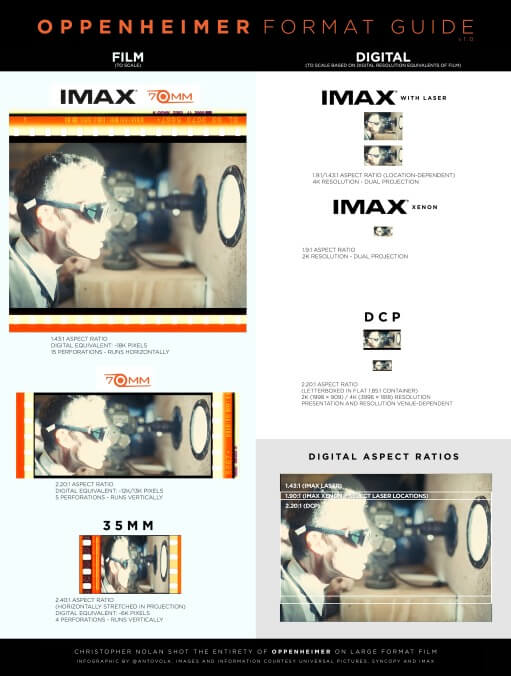"Croppenheimer" explained: How to pick the best format to watch Oppenheimer
Confused by all the options Christopher Nolan bestowed upon us for Oppenheimer? You’re not alone. Thankfully, our hassle-free viewing guide is here to help

We’re mere hours away from Christopher Nolan dropping a cinematic bomb on us. Oppenheimer opens in theaters Friday, July 21, with some early screenings starting July 20, and true to Nolan’s nature, the auteur has made seeing his movie “the way it was meant to be seen” a bit confusing. While we all love to take screenshots of Inception playing on a GameBoy Color, ironically declaring it the way Nolan intended, Nolan’s campaign to get people back into theaters has never been more urgent. Universal Studios is going to extreme lengths to appease the auteur’s vision, releasing Oppenheimer in numerous formats, including IMAX 70mm, standard 70mm, 35 mm, IMAX, and DCP. As a result, deciding what to see has become awfully difficult. Let’s clear a few things up.
What is “Croppenheimer”?
There’s a lot of conversation online about how to see Oppenheimer, or at least how to see all of it. IMAX 70mm is the only way to guarantee you’ll see the full, uncropped Oppenheimer. In theaters that don’t have the capabilities to project the full Oppenheimer, the film will be cropped, which is why some people refer to non-IMAX 70mm prints as “croppenheimer.”
As TikToker @umamiaex explains, the director and his cinematographer Hoyte Van Hoytema made the creative decision to shoot the film in two aspect ratios: DCI Standard 1.9:1, which any movie theater can handle, and IMAX Native 65mm, with an aspect ratio 1.43:1. The 65mm film has a much larger image, allowing for a picture that is equivalent to 18,000 pixels—compared to, say, the 4,000 pixels found on most televisions. It does get confusing, though. For example, the reason 65mm film is screened at 70mm is to allow 5mm for magnetic strips that contain the soundtracks. IMAX 70mm has perforations on the top and bottom of the film strip, as opposed to running vertically on typical 70mm or 35mm film. This makes room for an even taller picture that can fill the whole IMAX screen. Long story short: If you aren’t seeing the film in a theater that can handle 65mm native and 1.43:1 aspect ratio, the top and bottom of the screen will be cropped.
IMAX 70mm or IMAX?
Short answer: IMAX 70mm is the Christopher Nolan-certified “way the film is meant to be seen.” It offers the full, uncropped version of the film projected on actual celluloid, offering 10 times the clarity of standard projection. IMAX with dual laser projectors can also offer the full Oppenheimer, but is location specific, so just because the ticket says IMAX, that doesn’t mean the movie isn’t cropped. IMAX 70mm is the only format guaranteed to have the full Oppenheimer.
Long answer: Christopher Nolan shot Oppenheimer in 5-perf 65mm and 15-perf IMAX film. “Perf” refers to the perforations on the film stock (the little holes on the side). The perforation on IMAX film runs horizontally, allowing for a much bigger image than traditional 70mm. This allows the IMAX 70mm to handle both aspect ratios, switching between them and filling the whole screen. It’s also why prints of the film are 11 miles long, weigh 600 pounds, and required an extension built onto the projection booth at the Chinese Theater in Hollywood.
Unfortunately, there are only 30 IMAX 70mm screens in the world, with just 19 in the U.S., so most people will be seeing the film in digital IMAX. As we all know by now, not all IMAX screens are the same. The one we want for Oppenheimer is IMAX with Laser, which offers two aspect ratios and 4k resolution.








































